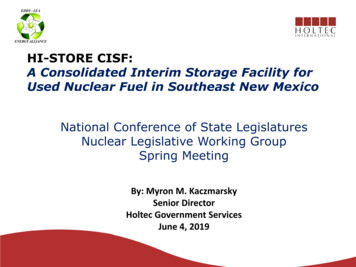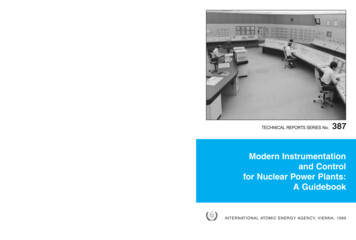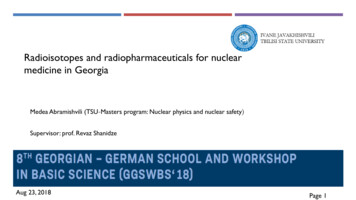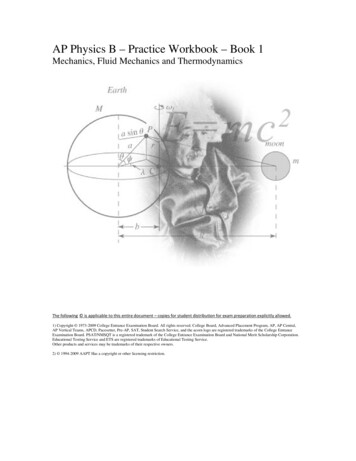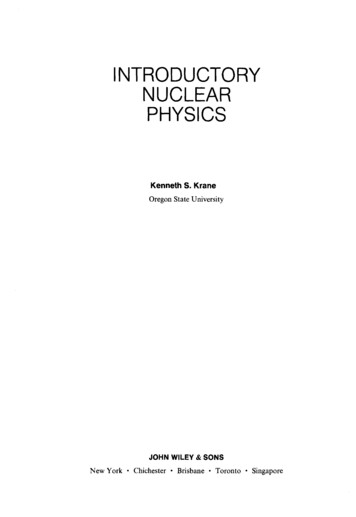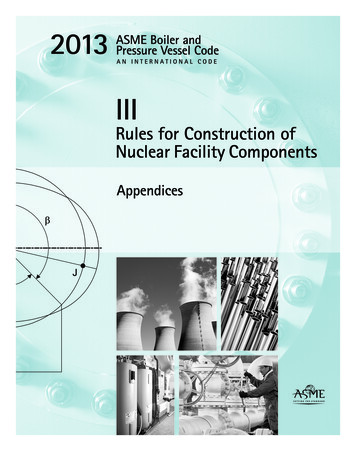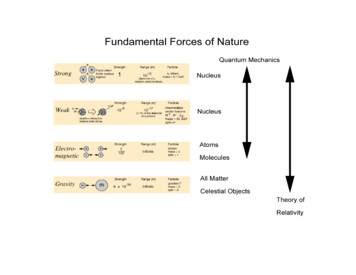
Transcription
Nuclear PhysicsNuclear Physics comprises the study of: The general properties of nuclei The particles contained in the nucleus The interaction between these particles Radioactivity and nuclear reactions Practical applications of nuclear phenomena:Medical radio-isotopes (imaging & therapy)Magnetic Resonance Imaging (MRI)Identification of materials (NAA, AMS)Dating of materialsPower generation (fusion and fission)Weapons of mass destruction (WMD)
Properties of NucleiEvery atom contains at its center an extremely dense, positivelycharged nucleus, which is much smaller than the overall size ofthe atom, but contains most of its total mass.The nucleus is made of protons and neutronsProtons have positive electric chargeNeutrons have no electrical chargeA OO 8Z16Z number of protons (atomic number)N number of neutronsA Z N(mass number)Isotopes of an element have the same number of protonsbut different number of neutrons. Isotopes have similarchemical properties, and different physical properties.
Isotope AZ N Atomic Mass (u) Abundance12 C6126612.00000098.90%13 C6136713.0033551.10%[The chemical atomic weight of carbon is 12.011 u]14 C614 6 814.003242Radioactive[146C decays by β- emission with Half-Life 5730 y]
Nuclear Size and MassThe radii of most nuclei is given by the equation:R R0 A1/3R: radius of the nucleus, A: mass number, R0 1.2x10-15 mThe mass of a nucleus is given by:m Auu 1.66 x10-27 kg (unified mass unit)
Nuclear Density5626Fe is the most abundant isotope of iron (91.7%)R 1.2x10-15 m (56)1/3 4.6x10-15 m[Compare with inter-atomic separations 0.1x10-9 – 0.3x10-9 m]V 4/3 π R3 4.1x10-43 m3m (56) 1.66x10-27 kg 9.3x10-26 kgρ m / V 2.3x1017 kg/m3[Compare with the density of solid iron 7x103 kg/m3]Since: m A u and R R0 A1/3ρ m / V u / (4/3 π R03) constantAll nuclei have approximately the same density
Nuclear Binding EnergyThe total rest energy of the separated nucleonsis greater than the rest energy of the nucleus.The difference is called the Binding Energy EBEB is a measure of the energy gained in formingthe nucleus from the individual nucleonsEB (Z MH N mN – AZM) c2Note that AZM is the mass of the neutral atom containing thenucleus, and MH refers to the mass of hydrogen (to balancethe Z electrons contained in AZM)
Binding Energy per NucleonThe binding energy per nucleon EB/A is nearly constant as afunction of A, suggesting that the nuclear force is saturated(a nucleon interacts only with its nearest neighbors).
The Nuclear ForceThe force that binds together protons and neutronsinside the nucleus is called the Nuclear ForceSome characteristics of the nuclear force are: It does not depend on charge It is very short range 10-15 m It is much stronger than the electric force It is saturated (nucleons interact only with near neighbors) It favors formation of pairs of nucleons with opposite spinsWe do not have a simple equation to describe the nuclear force
Nuclear StabilityThe energy of a group of nucleons in a square well ( a reasonablefirst approximation to a nucleus) is smaller if Z N. For largevalues of A we need N Z to compensate for the electric force
Nuclear StabilityPlot of N vs. Z for known nuclides.The stable nuclides are indicatedby the black dots.Non-stable nuclides decay byemission of particles, orelectromagnetic radiation,in a process called radioactivity
RadioactivityAlpha Decay: nuclei that are too large to be stable tend to decay byalpha decay, the emission of an alpha particle.[An alpha particle is the 4He nucleus, two protons and two neutrons]238 U92 23490Th αGamma Decay: the energy of internal motion (protons and neutronsin a nucleus is quantized. A nucleus has a set ofallowed energy states (ground state and excitedstates) much like in an atom. Transitions betweenstates lead to the emission of very energeticelectromagnetic radiation called γ (gamma) rays23892U* 23892U γ
RadioactivityBeta Decay: consist in a) the emission of an electron β- , b) theemission of a positron β , or c) electron capture.a) Nuclides with neutron to proton ratio too large for stabilitytend to decay by conversion of a neutron into a proton, anelectron and an antineutrino:n p β- νb) Nuclides with proton to neutron ratio too large for stabilitytend to decay by conversion of a proton into a neutron, apositron, and a neutrino:p n β νc) In certain cases an orbital electron can combine with aproton in the nucleus to form a neutron and a neutrino:p β- n ν
RadioactivityRadioactive decay is a statistical process. There is now way topredict when an individual nucleus will decay. However, it ispossible to predict the decay rate of a group of nuclei.If the initial number of radioactive nuclei at time t 0 is N0,then the number of remaining nuclei at time t is given by:N(t) N0 exp(-λt)The constant λ is called the decay constant and can be interpretedas the probability per unit time that a nucleus will decay
RadioactivityThe Half-Life T1/2 is the time required for the number ofradioactive nuclei to decrease to half the initial value N0N0/2 N0 exp(-λT1/2) T1/2 ln 2 / λThe mean lifetime Tmean, or lifetime, is thetime required for the number of radioactivenuclei to decrease to 1/e of the initial value N0λTmean 1 Tmean 1 / λThe number of decays per unit time dN/dt isthe activity of a sample, and is measured inCurie (Ci) 1 Ci 3.7x1010 decays/secondt1/2 T1/2τ Tmean
238Udecay series
14CDatingRadioactive 14C is continuously produced in the atmosphere[14N(n,p)14C, the neutrons being produced by cosmic rays].14Cdecays by β- emission with half life T 1/2 5730 y14C 14N β- νThe chemical activity of 14C is similar to that of 12C, so livingorganisms have the same 14C /12C ratio as in the atmosphere,which is about 1.35x10-12.When an organism dies it stops absorbing 14C, and the ratio14C /12C decreases. Measurement of this ratio allows thecalculation of the time of death of the organism.
Nuclear ReactionsA nuclear reaction is a rearrangement of nuclearcomponents induced by particle bombardment414 N 17 O 1 HHe 278114177N(α,p) 8ONuclear reactions are subject to the followingconservation laws:ChargeMomentum and angular momentumEnergyTotal number of nucleons
Nuclear ReactionsSome nuclear reactions release energy, whileother reactions require input energy to proceedThe amount of energy released or absorbed in a nuclear reaction(in the center of mass reference frame) is called the Q value, orreaction energy:In a reaction: MA MB MC MDQ (MA MB - MC - MD) c2If MA MB MC MD Q 0 exoergic reactionIf MA MB MC MD Q 0 endoergic reactionAn endoergic reaction will not proceed unless the incoming particleprovides the reaction energy Q (in CM)
Particle Induced Nuclear Reactions: are used mostlyfor nuclear physics research, and for analytical purposesThe reaction 7Li(p,α)4He can be used todetect Li in solids [1-2 MeV protons]
Neutron Induced Nuclear ReactionsNuclear reactions induced by neutron bombardment are used:a) In analytical techniques such as neutron activation analysisb) In the generation of energy by Fission or FusionIt is convenient to distinguish between fast and slow neutronsFast neutron kinetic energy 1 MeVSlow neutron or thermal neutron kinetic energy 0.025 eVThe probability for a reaction to proceed or Cross Sectiondepends strongly on the energy of the neutrons
Neutron Activation AnalysisLow energy neutrons are likely to be captured by nuclei, withemission of radiation from the excited nucleus, as in X(n,γ)Y.The emitted radiation is a signature for the presence of element XVarious layers of a painting are revealed using NAA
Fission and FusionBinding energy per nucleonThe binding energy per nucleonpeaks for A 70, then:a) splitting a large mass nucleusinto two medium mass nuclei(fission), orb) fusing two low mass nucleiinto a larger mass nucleus(fusion)result in the release of energy.
FissionUranium has two main isotopes:238U with an abundance of 99.3%235U with an abundance of 0.7%When 235U captures a thermal,or low energy, neutron it forms236U that decays by undergoingfission (85% of the time)n 235U 141Ba 92Kr 3nThere is about 1 MeV per nucleon higher binding energy in theproducts of the reaction than in the Uranium. As a consequence,more that 200 MeV of energy are liberated in this reaction.Furthermore, the emitted neutrons can induce additional fission
Chain Fission ReactionTo sustain a chain reactionone of the emitted neutronsmust be captured by another235U nucleusThe reproduction constant kis the average number ofneutrons from each fissionthat cause subsequent fissionk 1 the reaction will die outk 1 the reaction will be sustained (nuclear reactor)k 1 the reaction will run away (nuclear bomb)
Nuclear Fission ReactorFission of 235U is most likely for low energy neutrons. The neutronsemitted in fission are more energetic so they need to be slowed downby means of a moderator (water, graphite) placed in between the fuelrods. Control rods, of Cadmium or other materials, are further used toregulate the number of fission inducing neutrons
FusionIn fusion, two light nuclei such as deuterium 2H and tritium 3Hfuse together to form a heavier nucleus:2H 3H 4He n 17.6 MeVThe energy released per nucleon is larger than that released in fissionThe production of power from fusion of light nuclei holds greatpromise because of the relative abundance of fuel, and the absenceof some of the dangers inherent in fission.However, the technology necessary to make fusion practical, hasnot been developed yet.
FusionThe proton – proton cycle,resulting in the formationof 4He, and the release ofconsiderable energy, is theprimary source of the sun’senergyIn practice it is very difficult to generate the necessary densityof super-hot gas (T 107 K - plasma), and keep it confined, tofacilitate the fusion process.
Nuclear Physics Nuclear Physics comprises the study of: The general properties of nuclei The particles contained in the nucleus The interaction between these particles Radioactivity and nuclear reactions Practical applications of nuclear phenomena: Medical radio-isotopes


